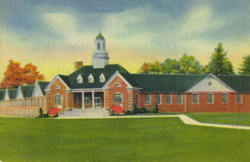Difference between revisions of "Thomas McRae Tuberculosis Home"
(Created page with "{{infobox institution | name = Thomas McRae Tuberculosis Home | image = ARmcrae.png | image_size = 250px | alt = | caption = | established = 1923 | construction_began = | c...") |
(No difference)
|
Latest revision as of 01:19, 20 February 2025
| Thomas McRae Tuberculosis Home | |
|---|---|
 | |
| Established | 1923 |
| Opened | 1931 |
| Closed | 2011 |
| Current Status | Closed |
| Building Style | Single Building |
| Location | Alexander, AR |
| Alternate Names |
|
History[edit]
The bill that created the McRae Sanatorium was introduced in the Arkansas General Assembly in 1923. It had strong support from the Arkansas Tuberculosis Association, particularly from its executive secretary, Erle Chambers. Governor Thomas C. McRae was president of the association after leaving office in 1925. Because he championed the cause, the sanatorium at Alexander bore his name. In 1924, a tract of land was chosen in Alexander because it was “near the center of Negro population” and close to Little Rock, which had additional medical facilities.
The sanatorium’s first superintendent (and only doctor) was Dr. Hugh A. Browne, a 1928 graduate of Howard University’s Medical Department. Knowing that few African-American doctors lived in Arkansas, Dr. Browne took an eighty-seven-percent pay cut (from $1,500 to $200 a month) to move to Arkansas to oversee the McRae Sanatorium. Facilities for black Arkansans were not given priority when it came to the allowance of state funds. When it opened in 1931, the McRae Sanatorium had only twenty-six beds; in 1933, ten more were added after an expansion was approved by the state legislature. In 1935, there were 160 people on McRae’s waiting list. Another expansion was approved in 1938, which paid for the creation of a dedicated patients’ building with facilities for 139 and a nurse’s home with a capacity of thirty-two. In addition, surgical facilities were added in the main building, including an operating room, dressing room, and sterilizing room.
By 1945, the waiting list at the McRae Sanatorium had increased to over 600 for the 196-bed facility. In 1946, the state legislature appropriated money for a four-story infirmary building, but it was not opened for patients until September 1949. Ten years later, in 1959, the legislature had a children’s building built on site, but new advances in medicine and surgery had cut the number of patients by 150 by that time. The children’s building and an auxiliary nurse’s home were occupied by July 1, 1960. Arkansas’s two sanatoriums remained segregated until 1967. Federal integration policies caused the two to combine, and the McRae site became the Alexander Human Development Center, which opened its doors in 1968. In addition to tuberculosis treatments, the Alexander center offered occupational, physical, and speech therapy; psychological assessments; general medical care; and rehabilitation services.
Overseen by the Arkansas Department of Human Services, the Alexander center operated for forty-three years until allegations began to arise in the early 2000s of neglect and rape of patients, failed safety inspections, and a general refusal to adhere to federal guidelines. These infractions prompted investigations, and the Arkansas-Democrat Gazette announced on May 18, 2010, that Governor Mike Beebe planned to close the Alexander Human Development Center. At the time, at least 109 men were living there. The center closed in 2011. The abandoned facility later came under private ownership before being purchased by the Alexander Police Department in 2018. A major fire damaged the structure on March 18, 2020 and has remained vacant since.